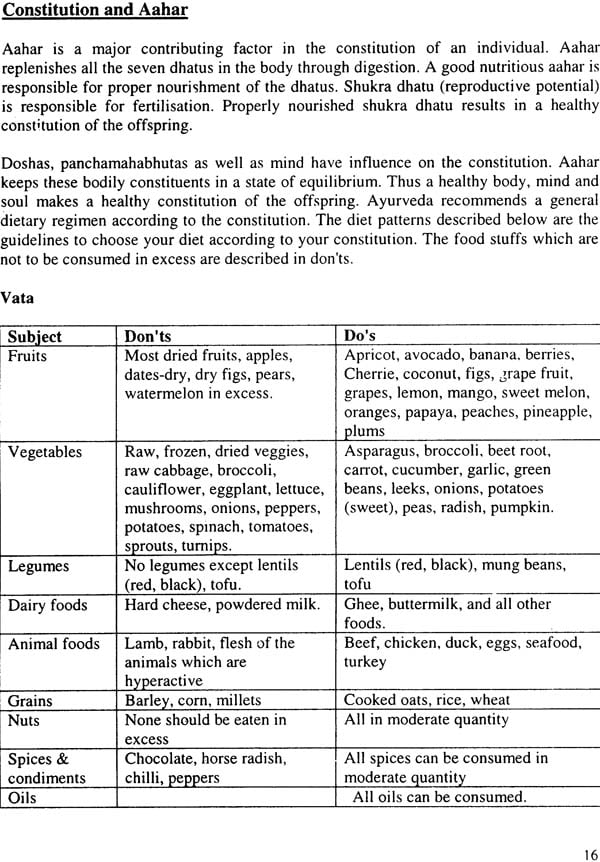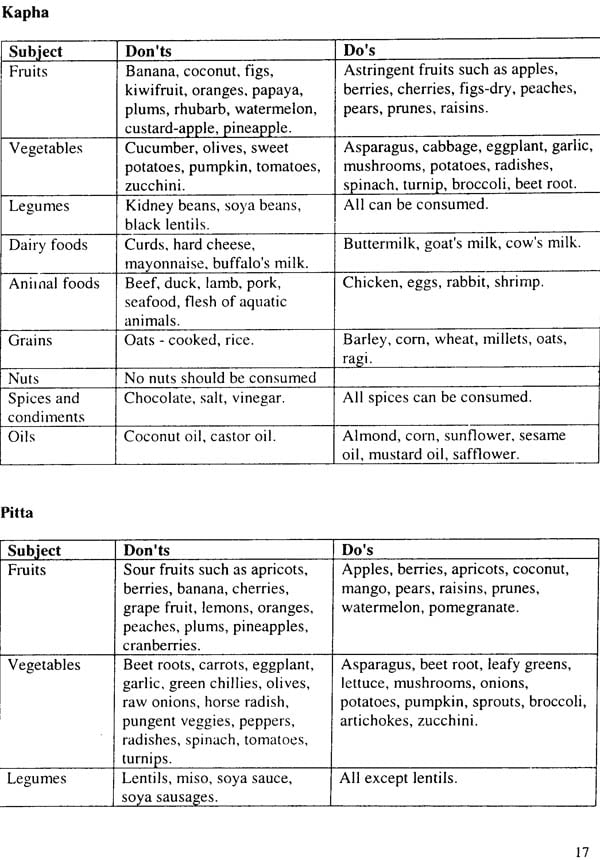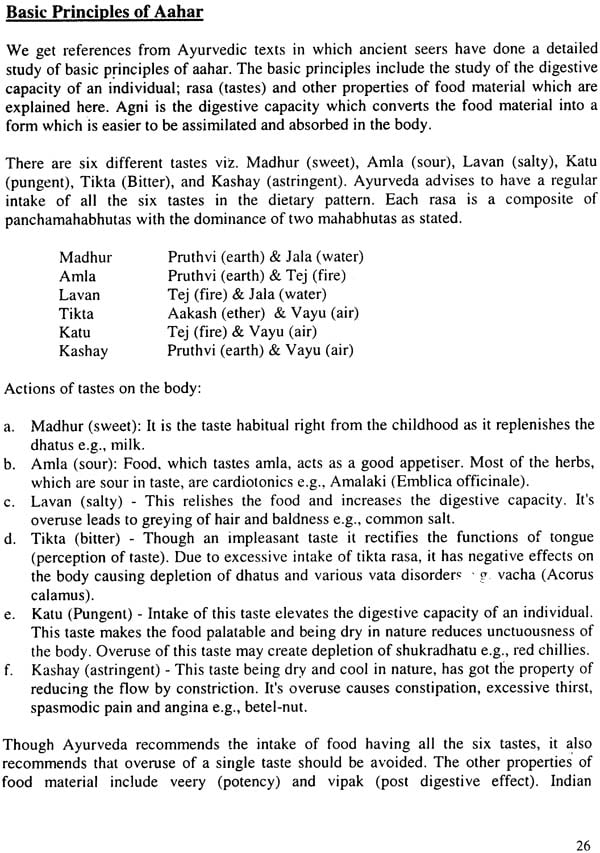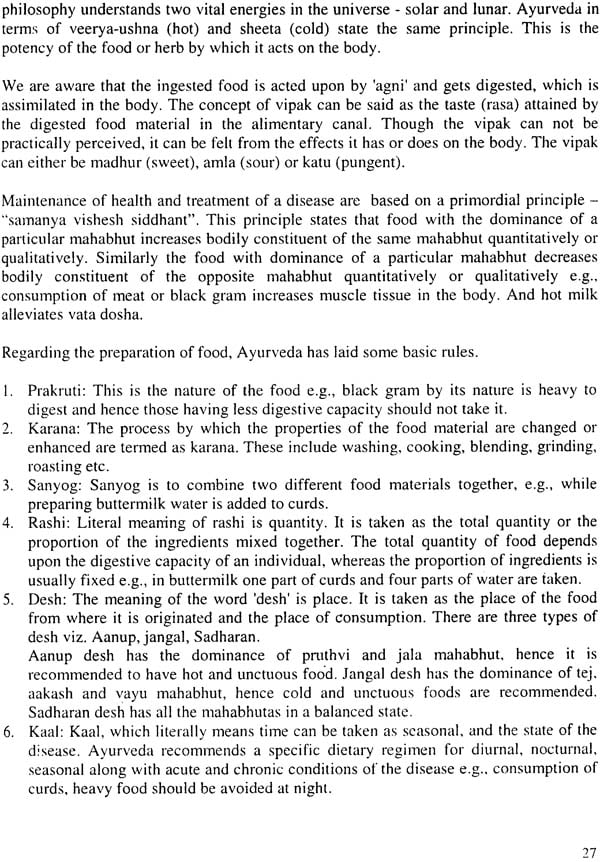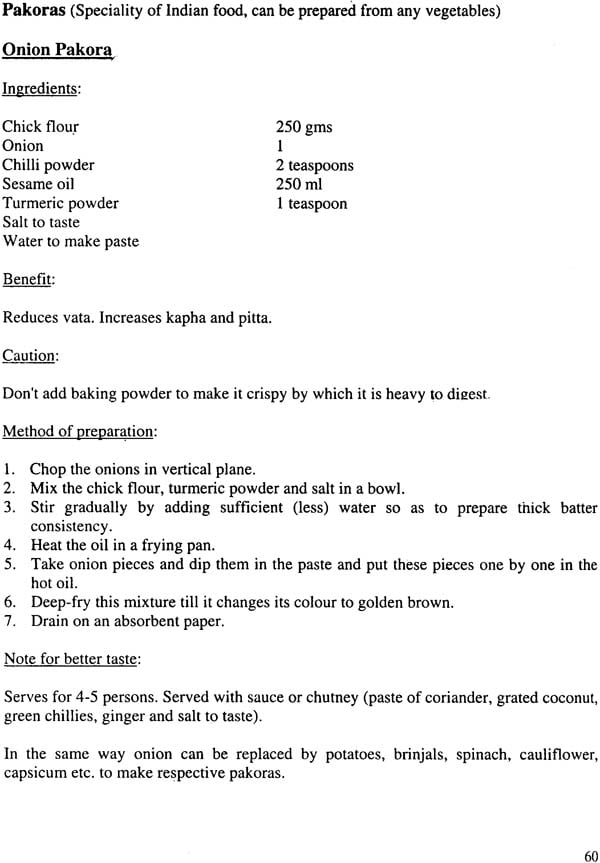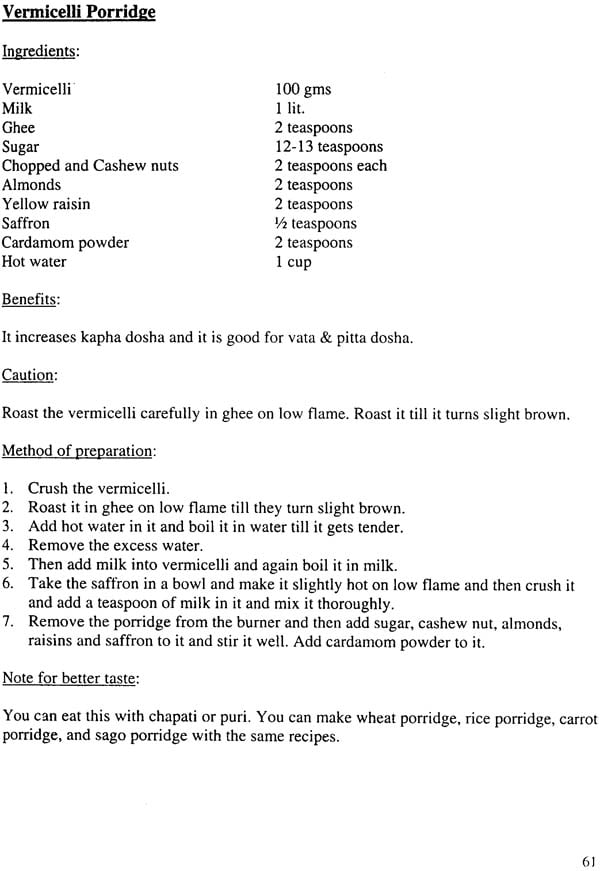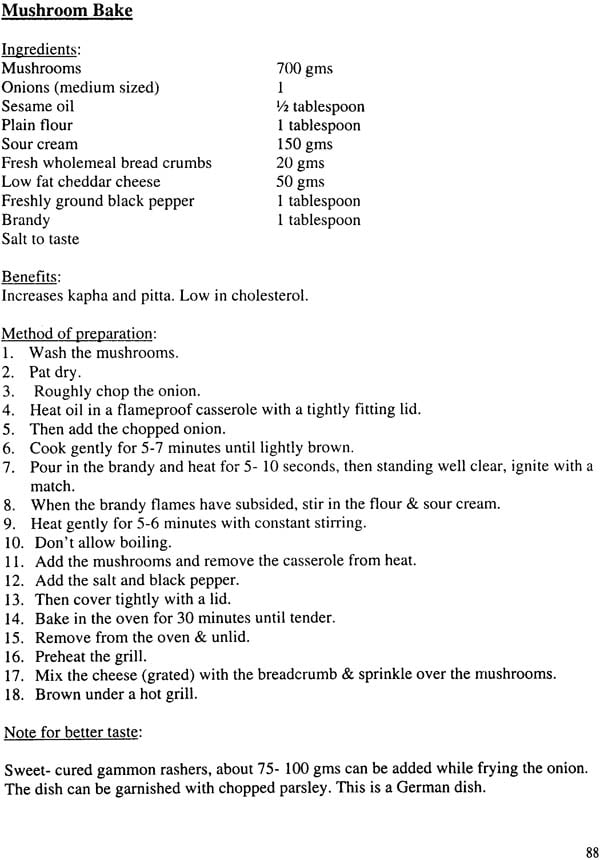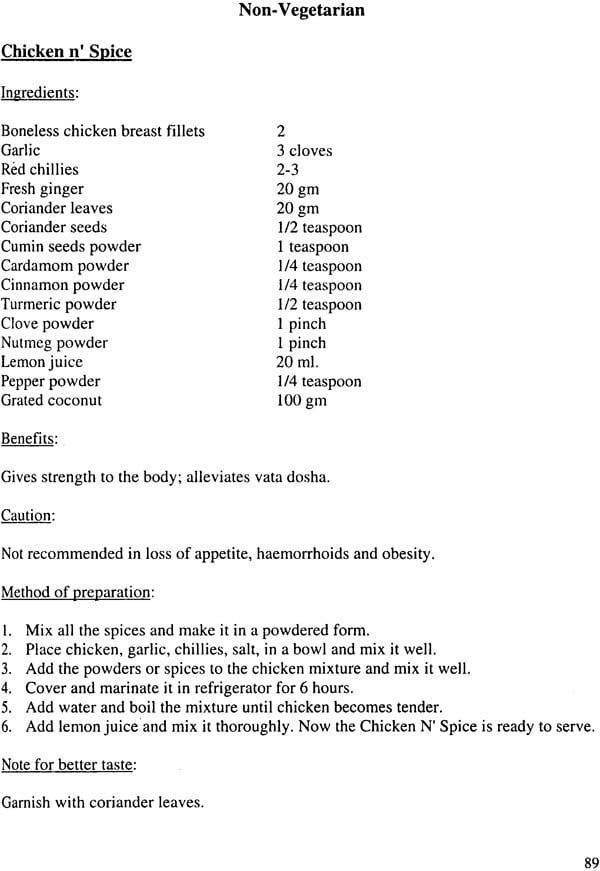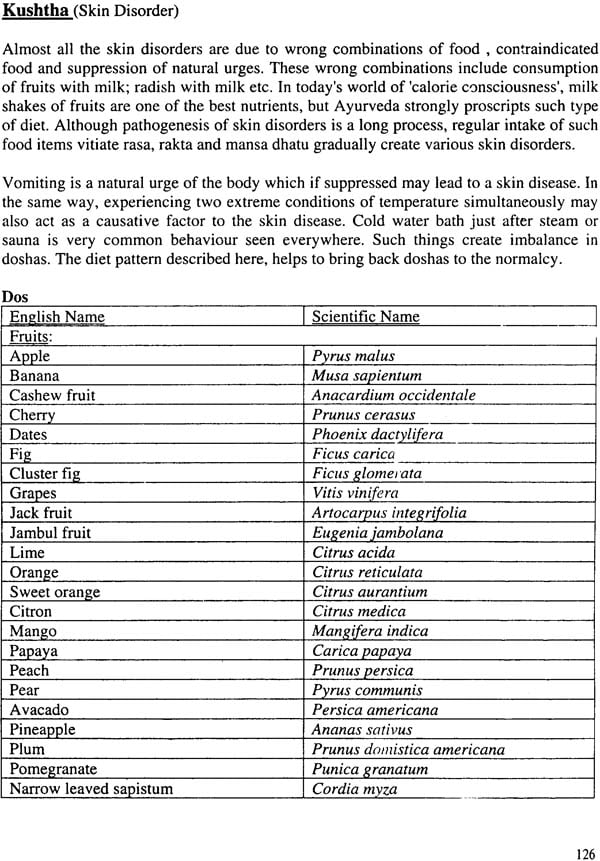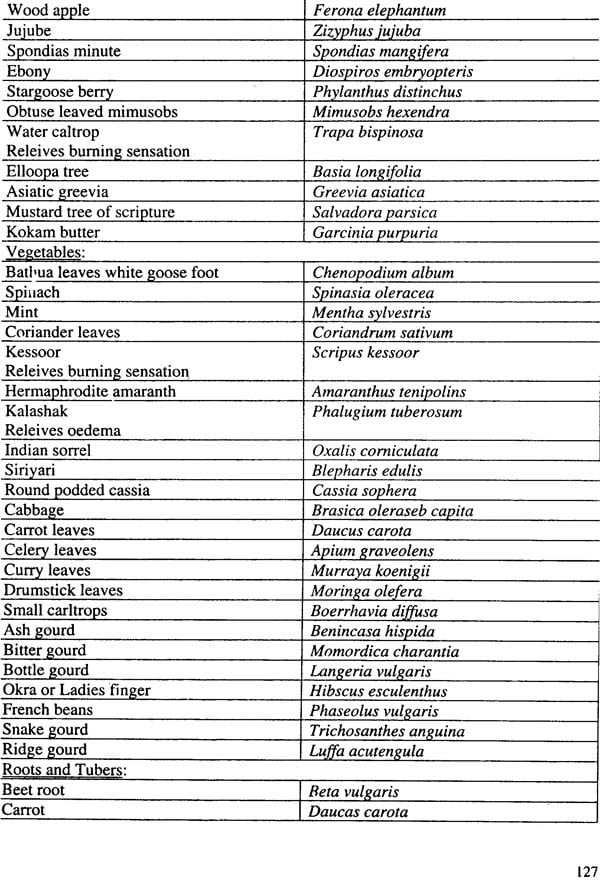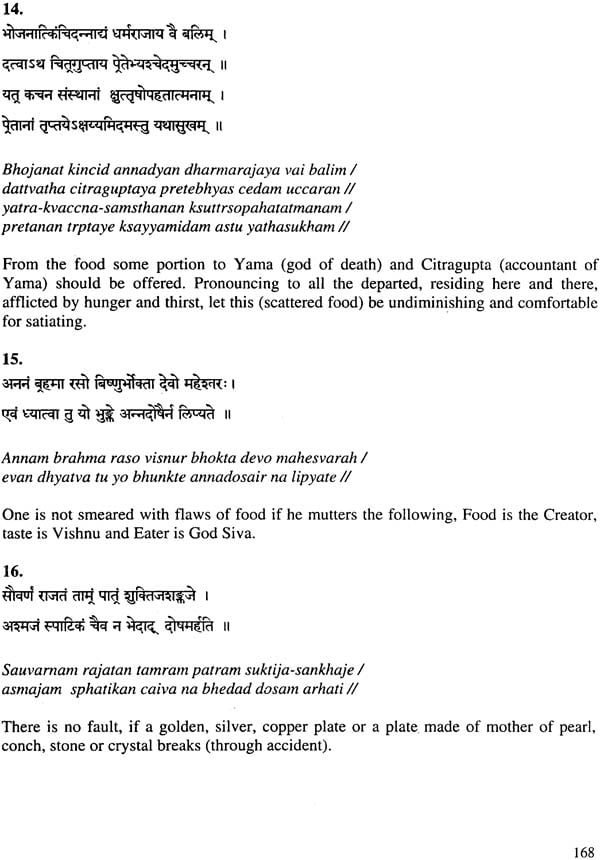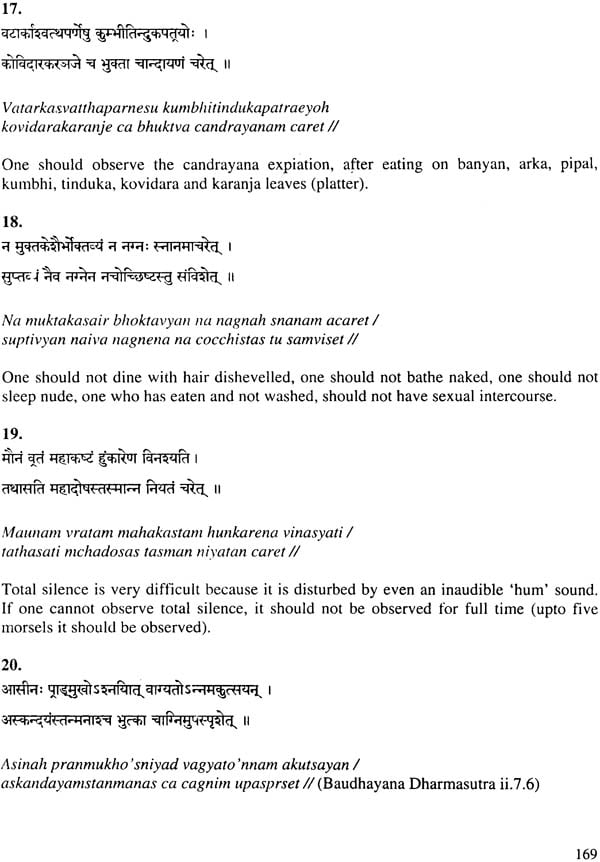
Ayurvedic Aahar: The Scientific Diet
Book Specification
| Item Code: | NAB982 |
| Author: | Dr. P.H. Kulkarni |
| Publisher: | Sri Satguru Publications |
| Edition: | 2002 |
| ISBN: | 8170307392 |
| Pages: | 189 |
| Cover: | Paperback |
| Other Details | 9.6 inch X 7.3 inch |
| Weight | 320 gm |
Book Description
Introduction
India, the land of rich culture and heritage has a tradition of a lifestyle and healing science, different from the existing modern medicine – AYURVEDA. It has originated several thousand years ago.
Dharma (to follow the spiritual, social and moral tents and duties towards the self and others), Artha (to earn livelihood), Kama (all kinds of desires) and Moksna (salvation) i.e. to break the cycle of birth, death and rebirth) and the four objectives of human life, which can only be achieved through good health and Ayurveda is the key to good health.
This oldest science of life has originated from the gods. It was initially perceived by Lord Brahma, which he further taught to Daksha Prajapati, who passed on this invaluable knowledge to Ashwinikumar and they taught it to Lord Indra.
The further hierarchy of Ayurvedic intellectuals in different Ayurvedic texts varies. As per Sushrut Samhita, Lord Indra taught it to Lord Dhanvantari. As per Charak Samhita, Bharadwaj (Atreya) learnt it from Lord Indra while Brahmavaivarta-puran considers Ayurveda to be the composition by Bhaskar on the advice of Daksha Prajapati.
Ayurveda understands human physiology in the form of panchamahabhutas (five elements) which are also the basis of mother nature.
Panchamahabhutas which constitute the universe as well as human being are:
Aaksha (Ether)
Vayu (Air)
Tej (Fire)
Jala (Water) and
Prithvi (Earth)
These Panchamahabhutas are Omni potent & occur in infinite varieties/proportions inn which each has its own quantities and attributes.
Aakash: In the structure of the Universe aakash represents the space whose essential quality is sound. The characteristics are-light, fine, smooth and soft with effects such as porous, lightness and producing.
Vayu: Vayu represents motion in the universe whose essential quality is touch. This mahabhut represent the principle of propulsion. The main characteristics are light, colds, dry, rough and fine. The main effects are stimulating motion and activating.
Tej: This mahabhut represents energy in the structure of the universe. The essential quality is Appearance. This represents the principle of conversion and transformation Hot, sharp, fine, light, dry and clear are the main characteristics of fire. Heats producing and stimulating are the main effects of Tej.
Jala: This mahabhut represents cohesion whose essential quality is taste and is related to the Moon. The main characteristics are liquidity, cold, slow, soft and unctuous. And the main effects of this mahabhut are moistening and dissolving.
Pruthvi: This mahabhut represents Mass and essential quality is smell. It represents the principle of solidity. Heavy, solid, hard, slow, rough and clear are the main characteristics of pruthvi. And growth along with stimulation is the main effects of this mahabhut.
Bodily constituents like doshas, dhatus and malas are the representations of panchamahabhutas.
Doshas viz. vata, pitta and kapha are the biological humours, which perform bodily functions i.e. synthesis of seven dhatus and also malas, the waste products. Doshas alongwith the their subtypes are as follows:
1. Vata: It represents the capacity, which controls all the activities of the body. It is predominant in the region below the umbilicus.
a. Pran vayu a subtype of vata dosha performs following functions are the site of chest region-respiration, ingestion of food, controlling of sense, memory, intelligence and cardiovascular system, other such as sneezing, swallowing, spitting etc.
b. Udan vayu also resides within the chest and performs functions from navel to nasal area. The functions include speech, expression, strength, complexion, memory etc.
c. Saman vayu-This subtype of vata dosha resides in the abdomen. It plays a vital role in the digestion process in accordance with agni (digestive capacity).
d. Vyan vayu – It resides at the cardiac region and it functions throughout the body. It is responsible for various movements inn the body such as yawning blinking of eyes and circulation of blood.
e. Apan vayu- It functions below the region of umbilicus. The functions are defaecation, micturation, parturition, ejaculation of seminal fluids and menstruation.
2. Pitta: It represents the capacity of conversion through digestion. Pitta lies mainly in the region between umbilicus and heart.
a. Pachak pitta- It lies between the stomach and umbilicus. It controls preliminary food breakdown and conversion; imparts energy to other subtypes of pitta dosha and regulates the temperature of the body.
b. Ranjak pitta- It’s functional site is said to be in spleen and liver. The red colour of the blood is a physiological effect of Ranjak pitta.
c. Sadhak pitta – It is located within the vital organs – Heart and brain where it performs the functions of memory, intelligence, art appreciation etc.
d. Alochak pitta- It is located within the eyes and performs the visual activities.
e. Bhrajak pitta – This pitta underlies whole skin. It controls temperature and complexion of the skin; important in the absorption of massage oils, balms, ointments and produces skin colour and body aura.
3. Kapha: It represents the capacity to cohesion. In kapha dosha Pruthvi and Jala Mahabhut are predominant. Kapha dosha is primarily located in the thoracic cavity, head and neck.
a. A valambak kapha: It lies in the chest region. It controls the secretions which protect the visceral organs from wear and tear. It also helps in the proper functioning of heart.
b. Kledak kapha: This subtype of kapha dosha is responsible for making food slimy and hence, easy for digestion. This Kledak kapha is situated in the aamashay.
c. Bodhak kapha: Tongue, which is the site of bodhak kapha, does the function of perception of taste.
d. Shleshak kapha: It is situated at the site of joints and carries out swift movements by lubrication.
e. Tarpak kapha: This subtype of kapha dosha mainly nourishes the sense organs and majjadhatu.
Dhatus: These are the constituents of the body that hold the body for the physiological functions. These are well explained physiologically rather than anatomically. Rasa, rakta, mansa, meda, asthi, majja and shukra are the seven dhatus. These have resemblance to and can be taken as plasma, blood tissue, muscle tissue, bone tissue, nervous tissue, reproductive potential of each cell (& semen) respectively.
Mala: these are the waste products excreted after digestion. Purisha (stools), mutra (urine), and sweda (sweat) are the three malas. The commingled state of these coustituents with a sound mind makes a perfect human being.
In brief Ayurveda is a science which takes care of the physical and mental wellbeing of an individual. It makes us understand more about ourselves with respect to nature. It will be a very narrow minded view to see Ayurveda, only as a treatment for disease. Metaphysically it covers a very broad aspect. Disease can be thought as a state of body, which a human being transpires to. Ayurveda heals a human being and not only the diseased state.
Back of the Book
Lot water has flown in the rivers since the Ayurveda Education series entered in globalizing the Science of Ayurveda through Media. The future of Ayurvedic science lies in the hand of young generation; equal importance has to be given to both practice and spreading the message of Ayurveda through media. Keeping these two points in mind a welcome book ‘Body, Mind and Soul’ was released with Dr. Maneesh Patwardhan on 5th Feb. 2000, and followed with ‘Ayurveda for Women’ with Dr. Pradnya Akkalkotkar on 10th may 2000.
In this e_world the importance of Ayurvedic diet, the most balanced diets has been neglected. In recent past few work has been done on this subject, however most of them lack in holistic approach. Thus there was the need of this volume. The digestive capacity of an individual is the most important factor in maintaining the health. The diet should be designed judging the digestive capacity primarily. Ayurveda has a different approach in understanding dietetics. It believes in properties of a particular food item then its quantity. There are various other factors that have a specific role in the effects seen on the body on the consumption of any food items. The food item or grain undergoes through many process, changing the properties e.g. Curds has different properties from grains when roasted before use, show different effects on the body. Combinations of food also has great value, as wrongly combined food items may lead to pathological conditions e.g. combination of milk with fruits (milkshakes) is harmful for the skin. The dietary pattern depends on different climatic zones and seasons too. Rice is the major part of diet in the coastal region of India; but it is consumed in the mountain region regularly, it doesn’t suit the body. There are many such aspects that should be considered while planning the diet. We have elaborated all these aspects among many others for better understanding and planning of your own diet. A number of recipes have been added in this work for the benefit of the people. Synonyms of various food material have been included in various languages.
| INTRODUCTION | 1-13 |
| Introduction to Ayurveda | 1 - 4 |
| Introduction to Aahar | 5 – 5 |
| Ancient Texts | 6 - 8 |
| Experts Comments | 9 - 13 |
| AAHAR AND YOU | 14-24 |
| Constitution | 14-15 |
| Constitution and Aahar | 18 - 18 |
| Season and Aahar | 19 - 21 |
| Mind and Aahar | 22 - 24 |
| PRINCIPLES OF AAHAR | 25 - 35 |
| Agni | 25 - 25 |
| Basic Principles of Aahar | 26-28 |
| Consumption of Food | 29-30 |
| Digestion Physiology | 33-35 |
| RECIPES | 36-101 |
| Sweet Dishes | 36-44 |
| Basundi | 36 |
| Caramel Custard | 37 |
| Garden Cress Seed Ladu (haliv seed) | 38 |
| GulabJamun | 39 |
| Moong Dal Flour Ladu | 40 |
| Rasala | 41 |
| Shatavari Kalpa | 42 |
| Sheera (sweet cooked cream of wheat) | 43 |
| Wholemeal Halwa | 44 |
| Milk Shakes/Lassi/Squash | 45-54 |
| Butter Milk | 45 |
| Dhanyakpanak | 46 |
| Grape Wine | 47 |
| Gruel | 48 |
| Lemonade | 49 |
| Masala Milk | 50 |
| Poppy Milk Shake | 51 |
| Raw Mango Crush | 52 |
| Sharkarodak | 53 |
| Tamarind Squash | 54 |
| Miscellaneous | 55-57 |
| Paan | 55 |
| Spicy Tea | 56 |
| Tea | 57 |
| Sauce | 58-58 |
| Peanuts Sauce | 58 |
| Toast/Roast/Sandwich | 59-61 |
| Bread Sandwich | 59 |
| Pakoras (Onion Pakora) | 60 |
| Vermicelli Porridge | 61 |
| Chutney/Raita | 62-67 |
| Brinjal Raita | 62 |
| Curry Leaves Chutney (paste/ powder) | 63 |
| Dates with Tamarind | 64 |
| Fresh Mixed Herb Raitha | 65 |
| Grated Coconut Chutney | 66 |
| Green Chutney | 67 |
| Soups | 68-76 |
| Carrot, Tomato & Cardamom Soup | 68 |
| Mixed Vegetable Soup | 69 |
| Moong Dal Soup | 70 |
| Mushroom Soup | 71 |
| Potato, Cabbage and Chilli Soup | 72 |
| Pumpkin and White Bean Soup | 73 |
| Spinach Soup | 74 |
| Tomato Soup | 75 |
| Watercress Soup | 76 |
| Vegetables | 77-88 |
| Boilded Potato Vegetable | 77 |
| Butter Milk Curry (Kadhi/Matha) | 78 |
| Cabbage Vegetable | 79 |
| Dal-Fry | 80 |
| Green Peas Vegetable | 81 |
| Green Spicy Curry | 82 |
| Spicy Mixed Lentils | 83 |
| Spicy Tomato | 84 |
| Stuffed Lady finger | 85 |
| Stuffed Tomatoes | 86 |
| Mashed Potatoes | 87 |
| Mushroom Bake | 88 |
| Non-Vegetarian | |
| Chicken n’Spice | 89-94 |
| Chicken Tikka | 90 |
| Fish Puff | 91 |
| Indonesian Spicy Mutton | 92 |
| Mince Meatballs | 93 |
| Pork Curry | 94 |
| Roti/Paratha | 95-96 |
| Sprouted Green Gram Paratha | 95 |
| Roti | 96 |
| Rice-Dishes | 97-101 |
| Idli – Rice Cakes | 97 |
| Jeera Fried Rice | 98 |
| Khichari | 99 |
| Rice | 100 |
| Spanish Rice | 101 |
| DISEASE AND DIET | 102-162 |
| Introduction | 102-102 |
| Amavata | 103-107 |
| Aphrodisiac Diet | 108-111 |
| Constipation | 112-116 |
| Grahani | 117-121 |
| Hyperacidity | 122-125 |
| Kushtha (Skin Disorder) | 126-130 |
| Nidranaash (Insomnia) | 131-133 |
| Obesity | 134-137 |
| Prameha (Diabetes) | 138-142 |
| Urinary Calculus | 143-146 |
| Vatavyadhi | 147-150 |
| Miscellaneous Disease & Aahar | 151-161 |
| Dietary Regimen after Surgery | 151-151 |
| Pregnancy | 152-155 |
| Post natal care/Perpeureum | 156-161 |
| Sansarjan Kram | 162-162 |
| SLOKAS | 163-178 |
| DICTIONARY (English, Botanical, Sanskrit, Marathi, Hindi, Gujurati, German, French) | 179-184 |
| PHOTO GALLARY | |
| BOOKS & THESIS | 185-189 |
| Books | 185-189 |
| Thesis | 185-188 |
| REFERENCES | 190-190 |
